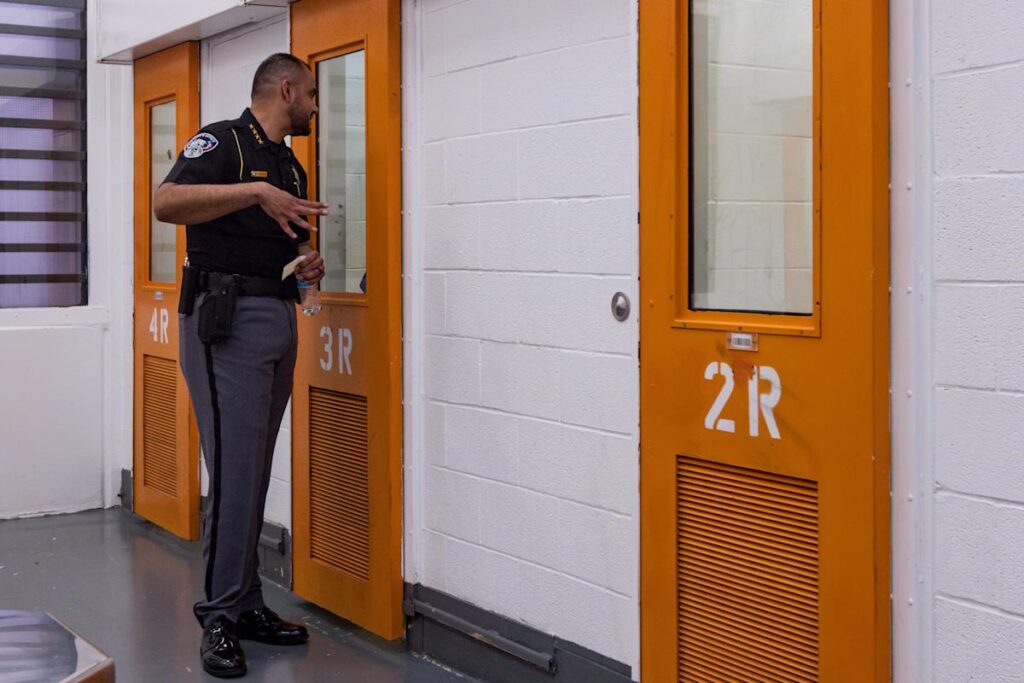The Downtown El Paso County Jail is more than 40 years old. Its layout is outdated, security monitoring systems aren’t reliable and the plumbing system is prone to failure.
Less than 50 detention officers work each 12-hour shift — at least 20 more would reduce overtime, prevent burnout and boost safety in the lockup.
New El Paso County Sheriff Oscar Ugarte, whose role includes operating the jail system, has started working to ensure the jail is safe for inmates, and, more importantly, is complying with standards set by the Texas Commission on Jail Standards.
El Paso County Sheriff Oscar Ugarte checks on an inmate in a separation cell block on Tuesday, April 2, 2025, at the El Paso County Downtown Detention Facility. These cell blocks do not have cameras but are subject to regular checks and are designated for individuals who are or were gang members or those with mental health conditions.
“When I took office, I inherited facilities and systems that had been neglected for far too long,” said Ugarte during a jail tour on April 2. “My priority is to ensure my team has the training and resources they need to do their jobs effectively. We’re focused on addressing the issues, improving oversight, and ensuring transparency while holding ourselves to the highest standards of accountability.”
The outdated jail has come under greater scrutiny following the discovery of three inmates dead in their cells. The deaths raise red flags on how difficult it is to monitor inmates at the aging facility by understaffed detention officers.
More: Man charged in son’s kidnapping dies in El Paso jail, elderly inmate dies days later
Ugarte provided a tour of the Downtown El Paso County Jail after the Texas Commission on Jail Standards filed a notice of non-compliance Feb. 25, claiming El Paso County Sheriff’s Office detention officers failed to conduct required physical checks on inmates.
The notice was given after inmate Joe Murvin, 72, was found Jan. 23 unconscious and not breathing in his cell. The cause of death was ruled natural causes. Two days after Murvin’s death, inmate Miguel Angel Montoya, 30, was found dead. Montoya’s death was ruled a suicide. A third inmate, Rafael Reyes, 54, was found dead at the jail March 7. His cause of death was ruled a suicide.
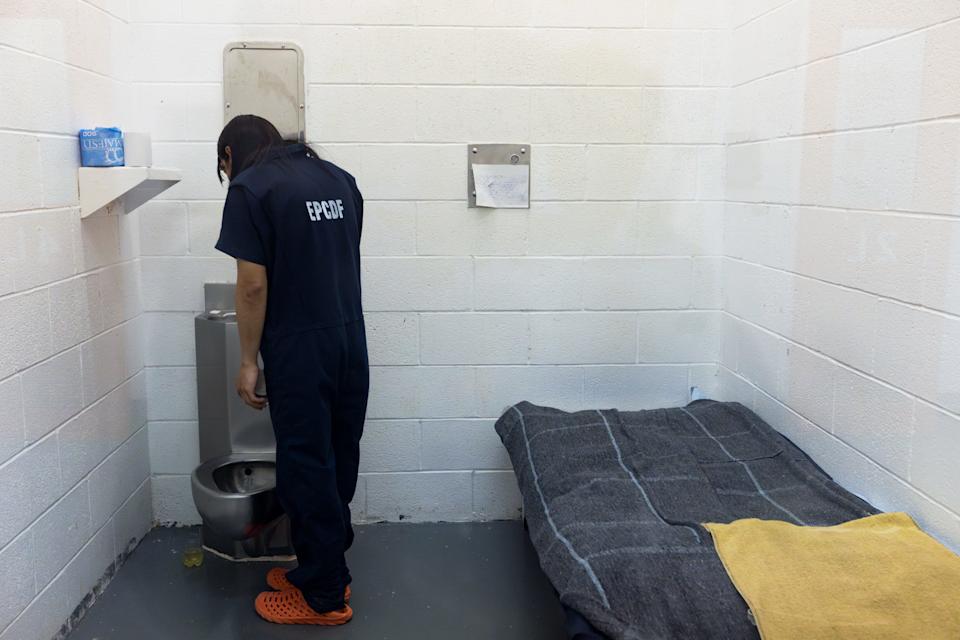
An inmate in a separation cell block brushes his teeth on Tuesday, April 2, 2025, at the El Paso County Downtown Detention Facility. These cell blocks do not have cameras but are subject to regular checks and are designated for individuals who are or were gang members or those with mental health conditions.
The notice was given after an investigation into Murvin’s death revealed systems in place showed jailers did not check on Murvin every 60 minutes as required by law.
The violations stemmed from a “glitch” in the system that detention officers use to record their rounds of welfare checks on each inmate, Ugarte said. The jail uses magnetic pipes on each cell. Jailers use a key fob-type system on the pipe. Each time the fob is used on the magnetic pipes, it records every time jailers check in on an inmate. The fob records the time, the cell and which detention officer conducted the face-to-face check.
More: Fort Bliss soldier accused of murder claims self-defense in deadly El Paso shootout
“The magnetic pipe tracking system indicated that we missed three checks, but once we got that report that we were in noncompliance, we went back and we checked the video footage,” Ugarte said. “In the footage for that floor, you can see where the officer is actually going in and conducting those checks. We’re not sure why the system had a glitch for some reason and those checks were not documented. We did send proof to the state.”
The Texas Commission on Jail Standards rescinded the notice of non-compliance April 3 after reviewing the footage that proved jailers had conducted their inspections.
“It is time we get a new jail,” Ugarte said. “This is a 40-year-old facility. It’s old, outdated and we need to keep up with the latest technologies. There is no doubt about it. We need to update and improve our jail.”
‘An old facility’
The Downtown El Paso County Jail first opened in July 1983. It cost $31 million to build. It can house more than 1,000 inmates. There are currently more than 500 inmates being held in the jail.
“It’s an old facility and it’s never gone through any renovations or upgrades until now,” Ugarte said. “The last study by the (El Paso County) Commissioner’s Court was about five years ago. They hired a private consultant to actually come do assessments on our jail facilities. At that time, that company actually recommended to build a new jail because of how old this facility is. But the past administration did not want to move forward with that recommendation.”
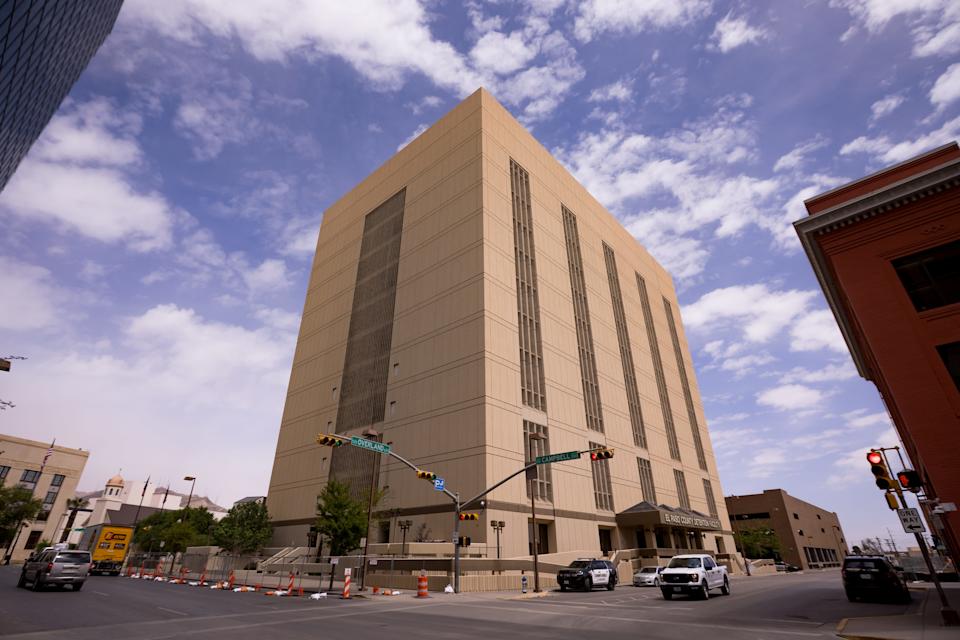
El Paso County Jail Downtown at 601 E Overland Ave.
While any discussion about building a new jail will come when the county begins working on its next annual budget later this year, Ugarte is working with the available funds to upgrade what he can.
The jail is currently being renovated to include more cameras in inmate housing areas and to add a computerized control system to open cell doors.
More: Socorro police arrest driver who allegedly followed woman, fired gunshots
Ugarte plans to address the need for a new jail with the El Paso County Commissioners Court. The sheriff’s office receives the most money from the county compared to other county departments, Ugarte said. The sheriff’s office’s current budget is about $130 million annually.
“I am definitely going to recommend that we need a new jail,” Ugarte said. “Absolutely. But like with any other project, it’s going to require a bond, a public safety bond, from the county. We can’t just build another one just from a regular budget.”

El Paso County Sheriff Oscar Ugarte talks in the general population cell block on Tuesday, April 2, 2025, at the El Paso County Downtown Detention Facility. These cell blocks do not have cameras but are subject to checks every 60 minutes. They house 20 inmates, with 10 beds on each side, and are designated for low-risk individuals.
Ugarte is working on preparing his budget to present to the Commissioners Court later this year to address building a new jail.
“I came in in January, the budget for the year had already started in October,” Ugarte said. “So I inherited the budget from the past administration. During the next budget talks, we will be presenting our budget and I will bring it up. That’s why these past few months, I have dedicated my time listening to the officers and doing assessments of the facilities. I am listening to the officers to see what their needs are and what their wants are. But as you can see walking through these facilities, they’re old already.”
‘Hard environment to work in’
Another critical issue impacting the El Paso jail is a shortage of detention officers. Currently, the sheriff’s office has about 450 detention officers between the Downtown jail and the far East Side jail annex.
Fewer than 50 detention officers work every shift at the Downtown jail. The officers work 12-hour shifts to meet the shortage. He needs about 70 detention officers per shift to run the jail at maximum efficiency and eliminate the need for overtime shifts, Urgate said.
Each shift at the Downtown jail has one lieutenant, two sergeants, four corporals and anywhere between 38 and 41 officers per shift, El Paso County Sheriff’s Office spokesperson Priscilla I. Contreras said.
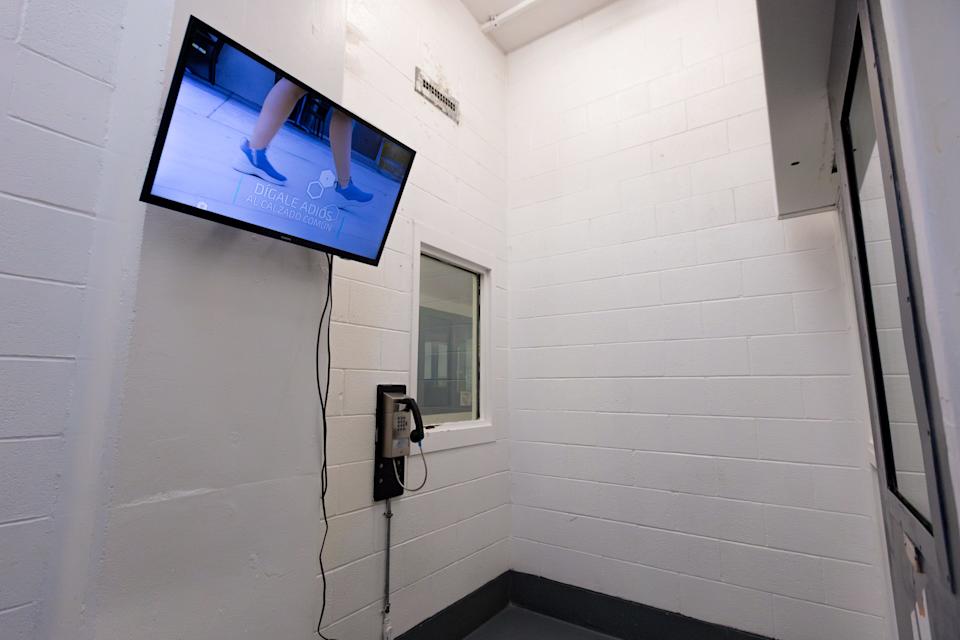
The day room where individuals are allowed to come out for one hour a day if they are housed in a separation cell block, also known as a segregation unit, is seen on Tuesday, April 2, 2025, at the El Paso County Downtown Detention Facility. These cell blocks are monitored by 24/7 surveillance cameras, and inmates are checked on every 30 minutes. They remain in the cell block for 23 hours a day.
It has been difficult to recruit officers, but the sheriff’s office continues job recruitment efforts to bring in new detention officers, Urgate said.
“It’s just right now, a lot of people don’t want to join law enforcement anymore, and that’s nationwide,” Ugarte said. “Also, this is a really difficult job. Being in this environment, you’re locked up yourself for 12 hours a day. So, 12 hours a day, you are in this environment. We do recruit. We have people pass the background check and start working here. Sometimes they come and work here, they do two, three weeks and they’re like, ‘no, this is not for me’ and then they leave.
“You are dealing with inmates who are aggressive. It’s a really hard environment to work in.”
Detention officer trainees earn about $47,600 a year, according to a Fiscal 2025 report by the El Paso County Human Resources Office.
The sheriff’s office is also competing with federal law enforcement agencies to hire and maintain staff, Ugarte said.
“What happens a lot, they come in here, they get that experience and then they go to bigger agencies, to the federal agencies,” he said. “The salaries that federal agencies are paying, we can’t compete as a county. So the feds will pick them up because they already passed background checks because they’re already working in a law enforcement facility.”
Life inside El Paso County Jail
Inmates are first booked into the jail and questioned by detention officers and medical staff. They are then classified as high risk, medium risk or low risk, detention officer Ruben Serna said. High-risk inmates are given orange and white striped jailhouse jumpsuits, middle-risk inmates are given red and white jumpsuits, and low-risk inmates are given green and white striped jumpsuits.
High-risk inmates are never housed with low-risk inmates. Medium-risk inmates can be housed with either high-risk or low-risk, Serna said.
“We don’t want low-risk people with misdemeanors or non-violent crimes, housed with high-risk offenders,” Serna said. “It is a safety issue. If we have somebody here that’s just going to spend the day for tickets, we don’t want them to be with somebody who committed serious robbery or is here for murder or is a gang member or anything like that.”
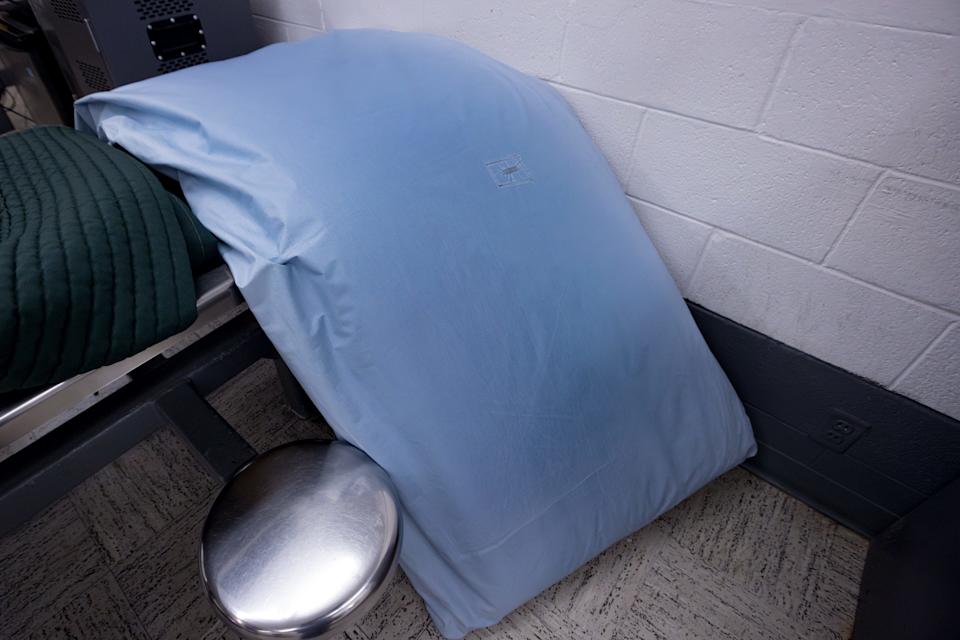
Detention Officer Serna shows the mattress issued to inmates on Tuesday, April 2, 2025, at the El Paso County Downtown Detention Facility.
Inmates qualify as high risk if they are charged with assaultive felony crimes or have prior assaultive felony crime convictions, Serna said. Inmates who have detainers, pending charges or past institutional behavioral problems also are classified as high risk.
Medium-risk inmates are inmates without current or previous assaultive felony crimes on their records, Serna said. Low-risk inmates are serving sentences for state jail felonies or misdemeanors.
More: Violent crime victims remembered during El Paso District Attorney’s Office ceremony
Inmates who may be suicidal, a threat to commit self-harm, a danger to other inmates or could be in danger from other inmates are kept in “acute observation” cells. These inmates are housed in a cell by themselves and jailers conduct face-to-face physical security checks every 15 minutes, Serna said.
The other inmates are housed in “non-acute observation” cells. Jailers check on these inmates every 30 minutes.
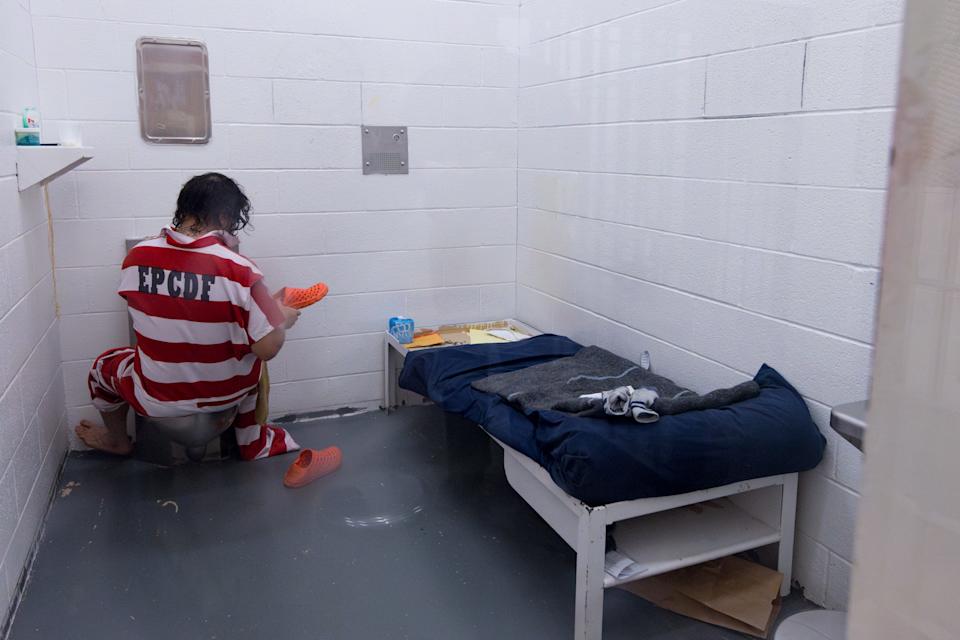
An inmate in a separation cell block puts on his shoes on Tuesday, April 2, 2025, at the El Paso County Downtown Detention Facility.These cell blocks do not have cameras but are subject to regular checks and are designated for individuals who are or were gang members or those with mental health conditions.
The jail also has administrative segregation and general population cells. Administrative segregation is for inmates who are required to be separated from other inmates. These inmates are separated from all other inmates for their safety, the safety of other inmates and the safety of the jail, Serna said. The El Paso Walmart mass shooter was kept in administrative segregation as he waited for his case to be resolved.
Most inmates are kept in general population. These inmates are kept in an area that houses 20 inmates. The housing area is flanked by two cells with 10 beds in each. Outside the cells is a general area with tables for the inmates to eat or watch TV. Jailers check on these inmates every hour.
All inmates get three hours of recreation time a week, including a chance to go outside in a secure area on the 12th floor of the jail.
Detention officers are responsible for dozens of tasks, including conducting head counts, physical checks, escorting medical and mental health personnel, enforcing jail rules, and responding to emergencies. Officers also escort inmates for their recreational time, appointments with their attorneys, and court hearings.
Aaron Martinez covers the criminal justice system for the El Paso Times. He may be reached at [email protected] or on X/Twitter @AMartinezEPT.
This article originally appeared on El Paso Times: Tour inside the El Paso County jail where 3 inmates recently died
Read the full article here

